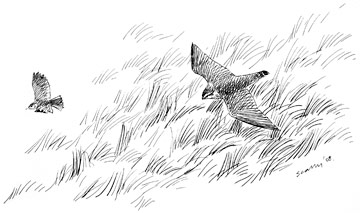
Merlin © Ray Scally
Merlins have always been much more common in Cheshire and Wirral in winter. Coward (1900) quoted Brockholes (1874) saying that a few birds remained through the winter in the Dee marshes, where they sometimes prey upon the feral pigeons which feed there. In Coward’s time the bird was occasionally encountered in winter in the marshes of the Mersey estuary, near Thornton and Ince, and less commonly on the plain. Boyd (1951) knew the Merlin as an infrequent winter visitor, seen one at a time, to areas around his Frandley home.
This Atlas map bears out that same general description today. The main concentrations are along the estuarine edges but an odd bird can be found almost anywhere in the lowlands. One bird showed an early return to the eastern hills. Compared to Hen Harriers and Short-eared Owl, there are proportionately more in the rough grassland around the Mersey than along the Dee saltmarshes, which may reflect the Merlins’ dependence on small passerines rather than mammals and larger birds. Merlins mainly hunt for passerines in winter but also take small waders up to the size of Redshank, usually skimming low over the ground and surprising their prey. They sometimes appear to cooperate with another Merlin or a different raptor, especially a Hen Harrier, in flushing prey. The submitted winter habitat codes reflect their use of open areas. 47% of records were of farmland, mostly grassland with 5% of stubble – birds presumably trying to surprise a feeding passerine – with 25% on grazing marsh or saltmarsh and 15% in estuaries.
The majority of British Merlins remain within Britain all year, with a median distance of 99 km between the breeding season and winter and movements being generally southerly and to lower altitudes. One ringed as a nestling in North Yorkshire was found dead near Warrington in its second winter in 1998. Most Icelandic birds winter in Ireland and western Britain so surely some of our wintering Merlins are of the Icelandic race Falco columbarius subaesalon. They are slightly larger and somewhat darker in plumage, but usually not safely distinguishable in the field, not least because northern British Merlins, from Shetland, Orkney and northern Scotland, are mainly within the Icelandic size range (Migration Atlas).
There were records submitted of 20, 28 and 26 Merlins in the three winters of this Atlas project.
Sponsored by xxxxxxxx

